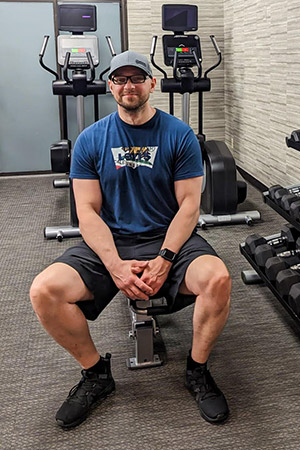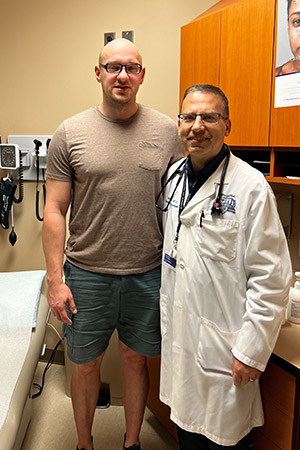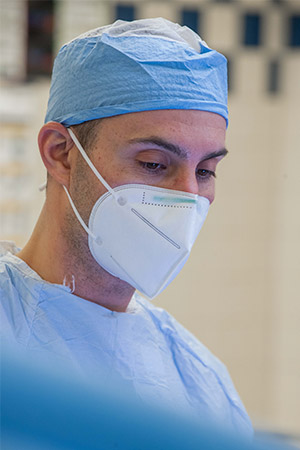Complex Tumor Collaboration Makes All the Difference for Weightlifter with Rare Disorder

An athlete for most of his life, Ignas Varkala, a technical SEO product manager for a digital marketing company, took on weightlifting 20 years ago when he moved to the United States from Lithuania as a teenager.
“I was a skinny kid and needed to get stronger to be part of the basketball team,” he explains. “At 6 feet 5 inches and only weighing 160 pounds, I decided to lift weights three times per day five days a week and that habit never died.”
Little did he know that weightlifting would not only keep him in shape, but it would play a role in detecting a potentially life-threatening rare condition.
Neck pain signals something is not quite right
On a routine day of weightlifting while doing squats with a barbell on his back, Varkala, who resides in West Bloomfield, felt pain in his spine that he had never felt before.
“It was a very odd feeling. I didn’t think that much about it, but over the next few weeks on Valentine’s Day, the pain increased to a point that it was excruciating. It felt like I had an ax in my neck and back and I had no power to move my head up.”
Varkala, who did not have any previous health issues, went to a local Urgent Care Center where treatment recommendations included Ibuprofen and a spine injection to ease the pain. He declined that treatment since he felt it was not getting to the root cause of the issue.

Henry Ford doctor orders tests and gets answers

The pain continued to progress over the next week. Through the Henry Ford Call Center, as luck would have it, Varkala was able to see Rashid Alsabeh, M.D. internal medicine physician at Henry Ford Medical Center-Farmington Rd. in West Bloomfield the same day.
Dr. Alsabeh says the history and exam did fit the typical common muscular strain neck pain. He suspected either disc, nerve or bone lesion and ordered an urgent neck MRI. The next day Dr. Alsabeh was notified that Varkala’s insurance declined the MRI, and six weeks of physical therapy would be required before approval. Dr. Alsabeh explained his concern to the insurance provider and was able to get approval for a CT scan.
“It came back abnormal so we had the MRI done right away which showed a bone tumor that may be pinching the spine cord,” Dr. Alsabeh says. He then talked to the neurosurgery team for a follow up exam including being fitted for a neck brace.
“I credit the early discovery of his condition to his awareness of his symptoms and body signals, and appreciate his trust in me, and following all my recommendations,” Dr. Alsabeh adds.
Varkala says even though the news was not good he was thankful Dr. Alsabeh was able to work with his insurance company to provide a prompt diagnosis.
“It was not a good feeling to feel that you are as healthy and fit as one can be and at only 36 years of age you are dealing with something so serious. But I appreciated that Dr. Alsabeh was getting to the root cause of my problem.”
Tumor board meets to determine action plan

After additional tests were taken, doctors confirmed Varkala had a spine tumor in his vertebrae. As part of the comprehensive treatment plan, a tumor board team including otolaryngologist Samantha Tam, M.D. and specialists in neurosurgical and orthopaedic spine surgery, radiation oncology, neuroradiology, pain medicine and others reviewed his condition and determined surgery to remove the tumor would be the best course of treatment.
“My neurosurgeon Dr. Adam Robin was amazing,” said Varkala who became a United States citizen the week before his surgery took place. “He was very thorough in answering my questions and said to me you now have three weeks to process this before treatment begins. And he was right, I was freaking out for the first two weeks and by the time surgery was scheduled I was as cool as a cucumber.”
Complex surgery a success
The complex surgical procedure to repair the spine tumor that had eaten away at his vertebrae and caused a fracture, took seven and a half hours and involved a team of specialists including Dr. Robin.
He explains that due to the experience of the spine tumor board and because the tumor appeared to be infiltrating into the bone, an approach from the front of the neck involving surgical removal of the entire tumor without violating its capsule was recommended.
“This involves not only taking the tumor out but taking the tissues around the tumor out as well, then detaching the front of the spine from the back of the spine, so the tumor can be removed in one piece to minimize the spillage of tumor cells into surrounding areas,” says Dr. Robin.

Kevin Taliaferro, M.D., orthopaedic surgeon at Henry Ford who was part of the surgical team explains the orthopaedic/neurosurgery team was able to collaborate to use O-arm CT navigated instruments, an intra-operative CT scanner providing a ‘map’ of the spine and transferred to the navigation system. The instruments used shows the location and direction of the instruments on the 3D scan to guide the surgery.
“By doing this we were able to get within a millimeter accuracy to remove all of the cancerous tissue without sacrificing surrounding healthy tissue,” Dr. Taliaferro says. “This helps ensure a faster recovery and a quicker return to normal activities once the healthy bones fuse together in his neck.”
Surgery to remove the tumor went well but further testing on the tumor tissue after surgery revealed that Varkala’s spine tumor was caused by a rare condition, Langerhans cell histiocytosis (LCH) in the adult lumbar spine. The rare disorder occurs when the body produces too many Langerhans cells (histiocytes), which are a type of white blood cell that helps fight infection. The condition can damage tissue or cause lesions to form in one or more places in the body. LCH was previously considered an inflammatory or autoimmune disease but was recognized as a blood cancer in 2008 by the World Health Organization.
Dr. Robin explains that initially, due to the imaging findings, it was determined that the cancer may have been coming from the bone itself. “Partly due to the rarity of an LCH diagnosis in this region, we were surprised and relieved in some ways to find LCH. Additional treatments, when warranted, can be very effective against LCH.”

Hematologist, Vijayalakshmi Donthireddy M.D. will continue surveillance since surgery was considered curative and a recent PET-CT looked positive.
For Varkala, he believes his life-long habit of keeping in shape helped him tremendously in his recovery after surgery.
The day after his complex surgery, he was walking a few steps in the hospital. That escalated quickly when he started walking over two miles a day only four days later.
“The doctors emphasized that walking was very important in my recovery and I quickly realized how important it was because after going back to work and sitting in my desk, I would experience pain if I didn’t take breaks,” he said. “If I walk four to five miles a day I don’t have pain. In fact, given everything I’ve gone through I feel great!”
.svg?iar=0&hash=F6049510E33E4E6D8196C26CCC0A64A4)

/hfh-logo-main--white.svg?iar=0&hash=ED491CBFADFB7670FAE94559C98D7798)